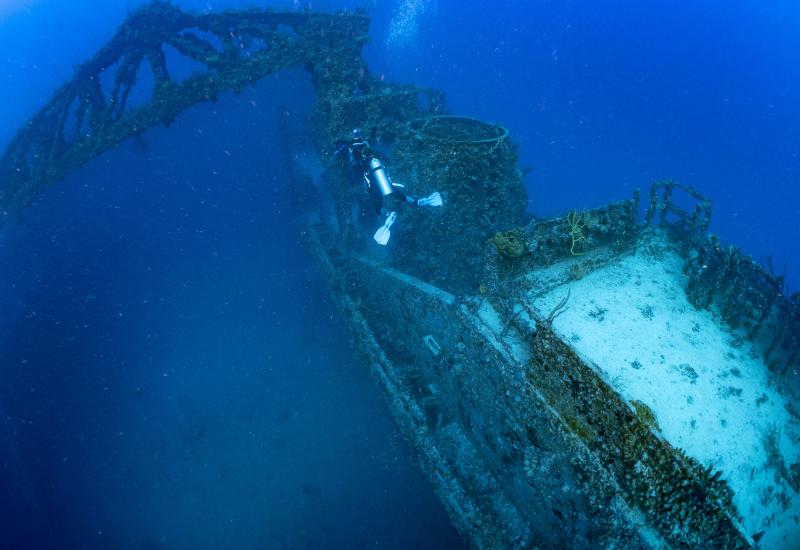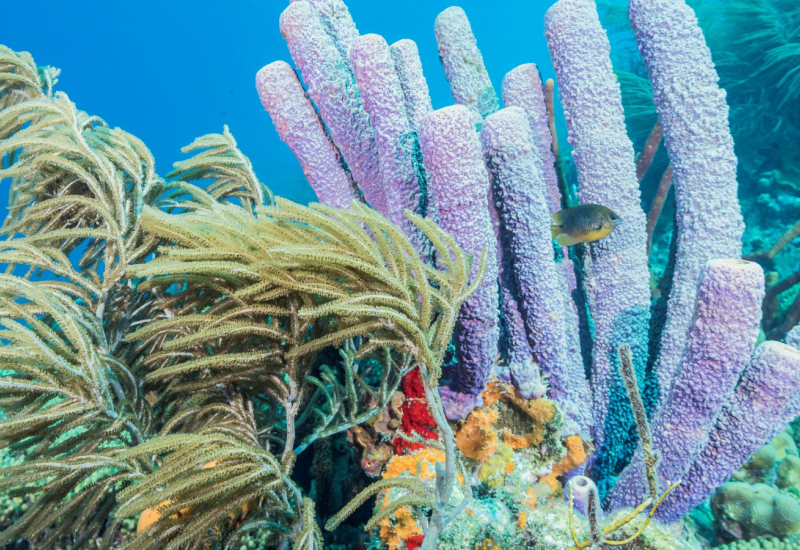Shark Diving Cocos Island, Costa Rica
It’s a tropical eastern Pacific island so remote, it seems untouched by time and man, offering underwater thrills unmatched in this hemisphere. A week of diving with Aggressor Fleet at Costa Rica’s Cocos Island reveals not only incredible beauty and diversity, but also how threatened and vulnerable this special place is. And who better to accompany us than a guy who knows a thing or two about wilderness: Survivorman.
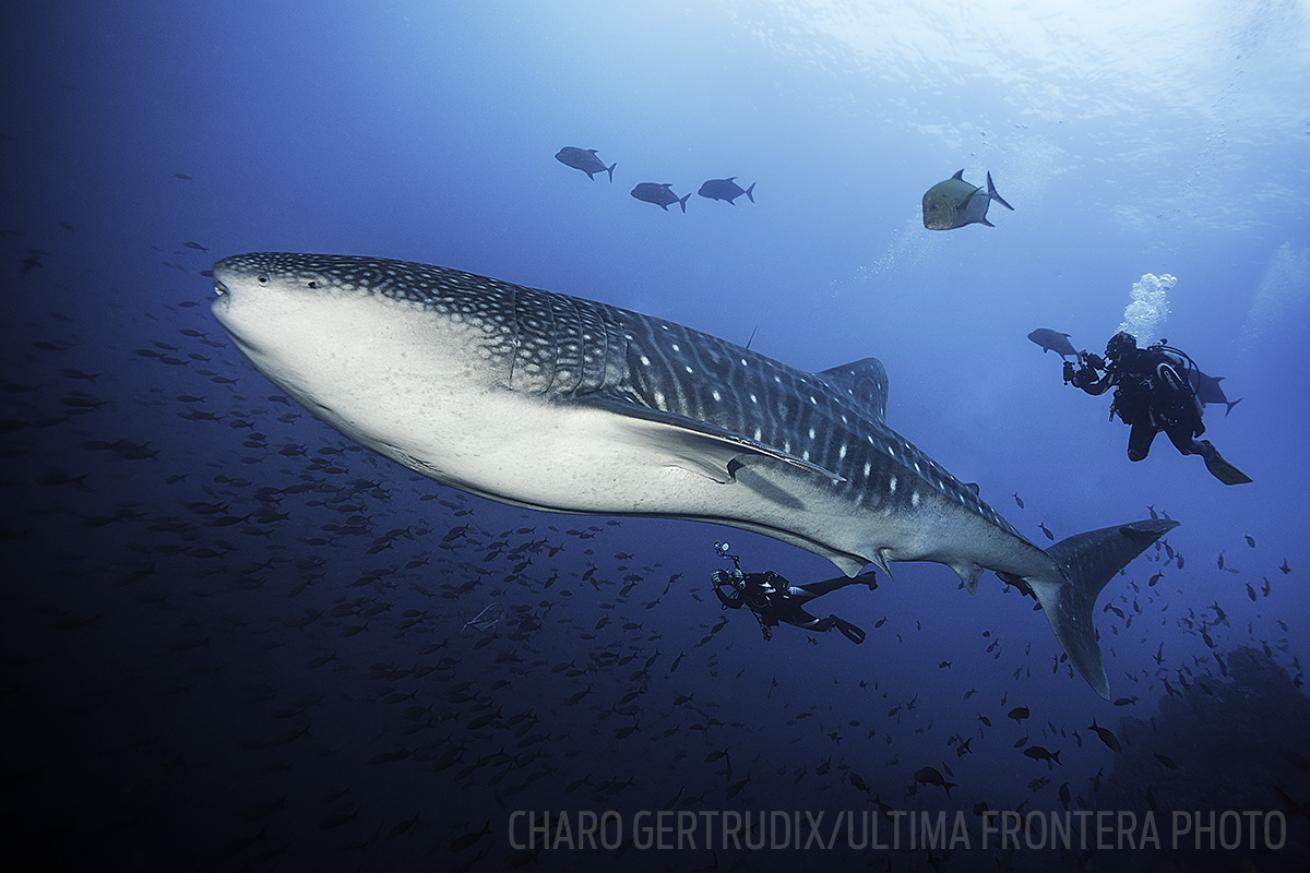
Charo Gertrudix/Ultima Frontera PhotoWhale sharks can be found year-round in Cocos Island, Costa Rica, especially at sites like Dirty Rock and Manuelita Deep.
Just beyond my dive buddy, I think I see spots. The water isn’t so clear — soupy is good when you’ve crossed 350 miles of open ocean in search of pelagics — and my eyes are playing tricks. Who hasn’t imagined the outline of a manta or a humpback in the distance, the product of intense, focused desire? Clearly, I’m hallucinating.
The 36-hour sail from Puntarenas, Costa Rica, to Isla del Coco gave me ample opportunity to repeat my mantra approximately 20,000 times: whale shark whale shark whale shark whale shark ….
Now here we were in the water at last, at a site called Dirty Rock, on the first plunge of our second day of diving from Okeanos Aggressor II. And I’m definitely seeing spots. Another moment ends all doubt: WHALE SHARK!
It circles in a slow, majestic curve, trailing living whiskers of remoras from its gargantuan jaw. Its strangely tiny eyes seem unseeing, or maybe I’m the tiny one, too insignificant to register with these giants. This one isn’t a behemoth — Rhincodon typus can grow to 40 feet — but it dwarfs our 25-foot panga. It sails overhead at a stately pace that’s still way too fast, leaving a group of divers doing an underwater shimmy-shake, fist-bumping like mad. Nobody cares what happens next — or, perhaps, ever: We’ve seen a whale shark in Cocos.
In a happy daze, we make our way around the rock counterclockwise, voracious little whitetip sharks everywhere. When we get around to the backside, we find the parade — holy moly, there’s every kind of life here, all up and down the water column. Parrots, squirrelfish and jacks, jacks, jacks, thousands milling around like rush hour in a subway station, all going in many directions at once. A hundred feet below on the sand, a couple of hammers and a good-size Galapagos shark circle endlessly.
A fellow diver taps me on the shoulder and points into the blue. What are we looking at? Galapagos sharks? Hammers? Then I can’t believe it: The whale shark is back for another lap. Once again, it’s oblivious to us, or maybe just uninterested, as it cruises overhead, so big it’s like its own ecosystem. Such elation among the divers! Unimaginable joy! Success! Victory! Rocky Mountain High! We don’t come down for days.
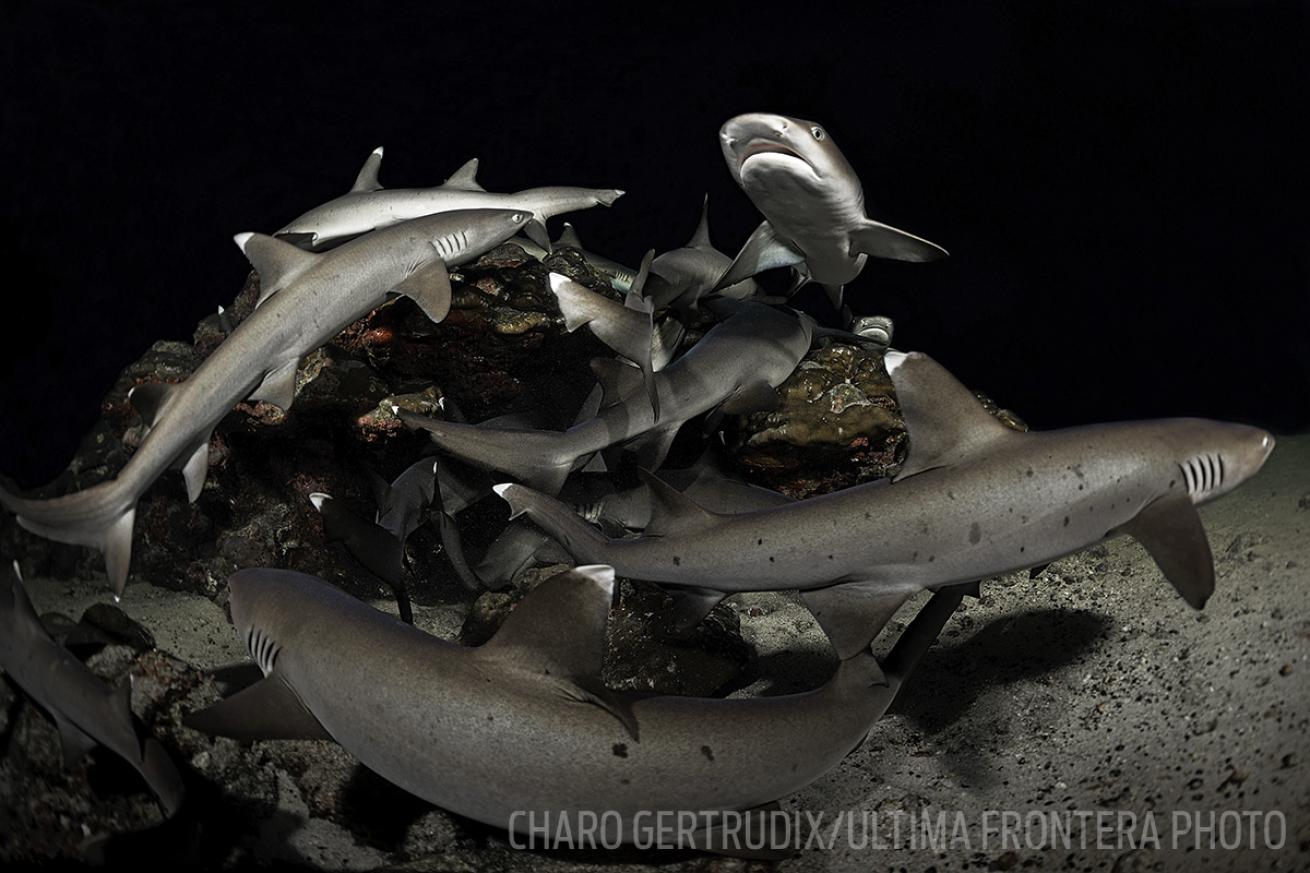
Charo Gertrudix/Ultima Frontera PhotoDuring night dives from the Okeanos Aggressor II, you'll likely see dozens of whitetip sharks having a feeding frenzy.
Virgin Sacrifice - Shark Diving in Cocos Island
The safety briefing alone lasts nearly an hour and a half.
Each diver is issued a satellite-powered GPS SPOT personal tracker and instructed how to use it — in the event of trouble, it will signal the yacht, the Costa Rican Coast Guard, the U.S. Coast Guard, rangers on-island, the yacht owner on the mainland and the yacht owner’s son. Feeling safer already, we practice with our devices — you have to really give the dry box a yank. “When you see five or six silky or Galapagos sharks around you, you’ll have no trouble opening it,” cruise director and divemaster Anival Morales assures us to nervous laughter.
Typical of Aggressor cruises, most of the 13 divers aboard — a mix of Americans and Canadians that includes wilderness expert Les Stroud, star of Discovery Channel’s long-running Survivorman series — are experienced, friendly, smart and curious. All are Cocos virgins — none has dived this remote destination before. Excitement is running high.
“Every dive is a drift dive,” we’re told, and also a shark dive. It’s a caution we hear again and again, along with admonitions to descend quickly and stay together. “In 10 minutes in the blue, you can go far,” Morales warns. How far? Briefing us on a dive we end up aborting, on Cocos’ rough southwest side, he tells us to bring a passport and Mastercard. ¿Qué? “Because if you go with the current into the blue, you will be in Galapagos tomorrow morning.”
Cocos and Galapagos belong to the same eastern tropical Pacific ecosystem that, along with Colombia’s Malpelo Island, is called the Golden Triangle, known for its rugged diversity, fantastic diving and overwhelming number of hammerhead sharks. Besides sharks and currents, Cocos also is known for its thermoclines. Those sudden temperature differences are the lifeblood of Cocos, driven by the Costa Rican Thermal Dome, a fluid area that varies from 200 to 800 miles across where wind and currents produce upwellings of deep, cold, nutrient-rich waters, creating a delicious stew and a beckoning way station for oceangoing animals all up and down the food chain.
Cocos’ rocky, raw terrain — with a thick jungle covering all but the most vertical slopes — reflects the forces that created it, both tectonic and volcanic. It’s gorgeous but forbidding: If you were shipwrecked here, you’d better hope you washed up with a canoe and a ladder, because aside from a bay or two, you’re never getting to the interior from most of this cliffy coast. Although with more waterfalls than you can count — more than 200 by some estimates, many ringing the 10-square-mile national park immortalized in scenes from Jurassic Park — you would at least be assured of prolonging your demise with plenty of fresh water.
Those waterfalls are powered by 275 inches of rain per year. (Let’s let that astounding figure sink in a moment.) “Is raining every day,” Morales says with a mournful smile one soggy morning. “Every day, every day, every day.” That moisture, which can turn a trickling stream into a plunging cataract overnight, is part of the forces that made Cocos a stopover for everything from whale sharks to whalers, who along with pirates knew well of the abundant fresh water, wood and coconuts here. Upside: Some biologists believe that Cocos’ hammerhead aggregations are driven by an abundance of less-saline water close to the surface; hammers might rise to kill hitchhiking parasites that prefer a saltier environment.
Diving with Survivorman Les Stroud
The first rule of Survivorman: Be prepared. (Actually it’s: Calm down. Or as Stroud says, borrowing a term from soccer: Take a knee. Think a minute. Assess.)
But preparedness counts. So when my GoPro dies midvoyage, Stroud quickly loans me his spare, and of course it’s a far more rugged model than my own. “Glad to help,” he says, deflecting any fan-girl fawning. And there are plenty of fan girls and boys aboard, several of whom have booked this trip because of Stroud. My dive buddy Marcia Barnes, 53, from Satellite Beach, Florida, is one. She once fed an entire church youth group for a week on a storm-racked Bahamian island using, among other Survivorman tricks, an ax made with a hammer and a butcher knife. “The kids learned you just have to adjust your thinking,” she says.
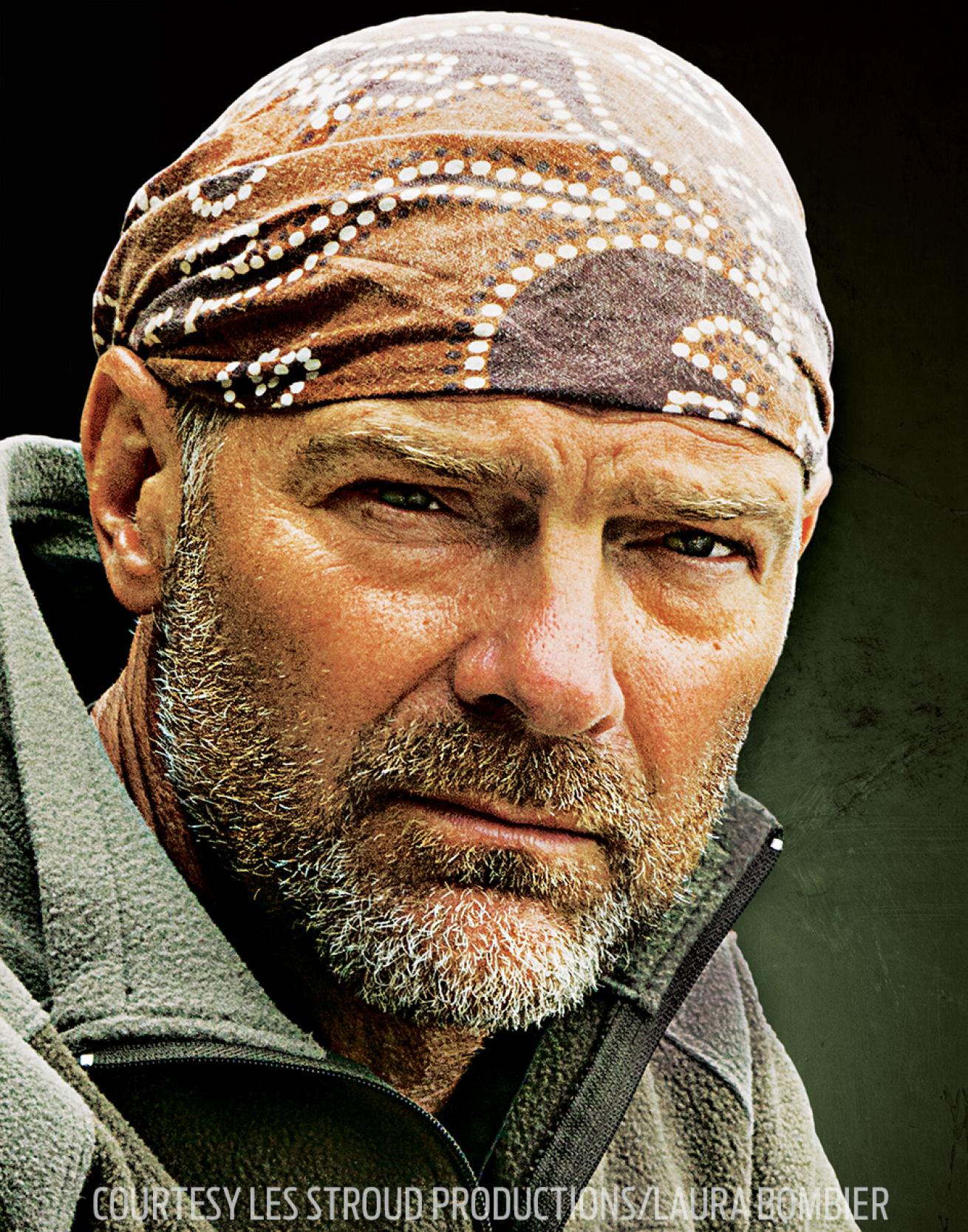
Courtesy Les Stroud Productions/Laura Bombier.
Dive with Survivorman
Join Discovery’s Les Stroud for a 10-day land-and-sea adventure with Aggressor in Sri Lanka. You’ll spend four days exploring the country’s wildlife parks and heritage areas from Aggressor’s Tented Safari Lodge (Jan. 18-21, 2017) and seven days diving the Indian Ocean aboard the new Sri Lanka Aggressor (Jan. 21-28, 2017). Learn more at aggressor.com.
For a guy who’s become famous by going it alone, it’s clear that positively motivating others to believe in themselves is Stroud’s mission. Fascinated by Jacques Cousteau and Tarzan as a kid, in the 1980s he abandoned a successful career in music video — he’s a gifted musician as well as a raconteur extraordinaire — to go native, becoming an expert in wilderness survival and teaching it to others. When Survivor became a hit in 2000, he recognized it as utter baloney, contacted Discovery and successfully pitched Survivorman, in which Stroud is dropped into remote locations for a week — alone and without tools or provisions — and fends for himself as best he can, all the while filming his experiences. It’s now been running intermittently since 2001, with nearly 60 episodes shot solely by Stroud in 120 different countries. (What scares him more than the jaguar that once stalked him through the Costa Rican jungle? “Disease and parasites.”)
Still, Stroud has gone a long way on chutzpah. He did his open-water certification a day before starting a Shark Week shoot in the Bahamas in 2007. He took to diving immediately.
“It’s the most meditative thing I do, other than walking in the wilderness,” he says. “You can be so anxious and frantic, and you jump in and just love the silence.”
A lot of Stroud’s message centers on awareness, and he practices what he preaches. When a diver aboard Okeanos Aggressor II falls ill due to a non-dive-related condition, Stroud knows something the crew does not: There’s a doctor on-island at that moment. (The diver had to sit out a few dips but was otherwise pronounced fine for travel.) Stroud had met the medic earlier in the week when he and his sidekick, Bushman Bob, a merry sprite from the Canadian deep woods who appears in the occasional episode, had executed an arduous island hike. How arduous? “I just about had a heart attack,” Stroud says of the steep, slippery hand-over-hand climb, which promptly discourages any other diver from attempting it.
Stroud and I buddy up at a site called Submerged Rock, a glorious 15-minute panga ride south from our mooring at Chatham Bay. The rock is a small underwater mountain with a shallow slope on one side and a sheer drop to invisible depths on the other. A large, fish-filled arch at 65 feet provides a playground for fish and divers alike. We drop in to unusually mild current and begin circumnavigating the seamount, adorable Cortez and barnacle blennies popping out everywhere. Watching reef fish chase each other around — leather bass, basslets, juvenile Pacific creolefish in huge numbers, Moorish idols — is incredibly fun, until we stumble on an unusual daylight thrill: a pack of whitetip sharks in a hunting frenzy, not far from the surface. We reach the top of the seamount, now bathed in morning rays, everybody as happy as divers can be.
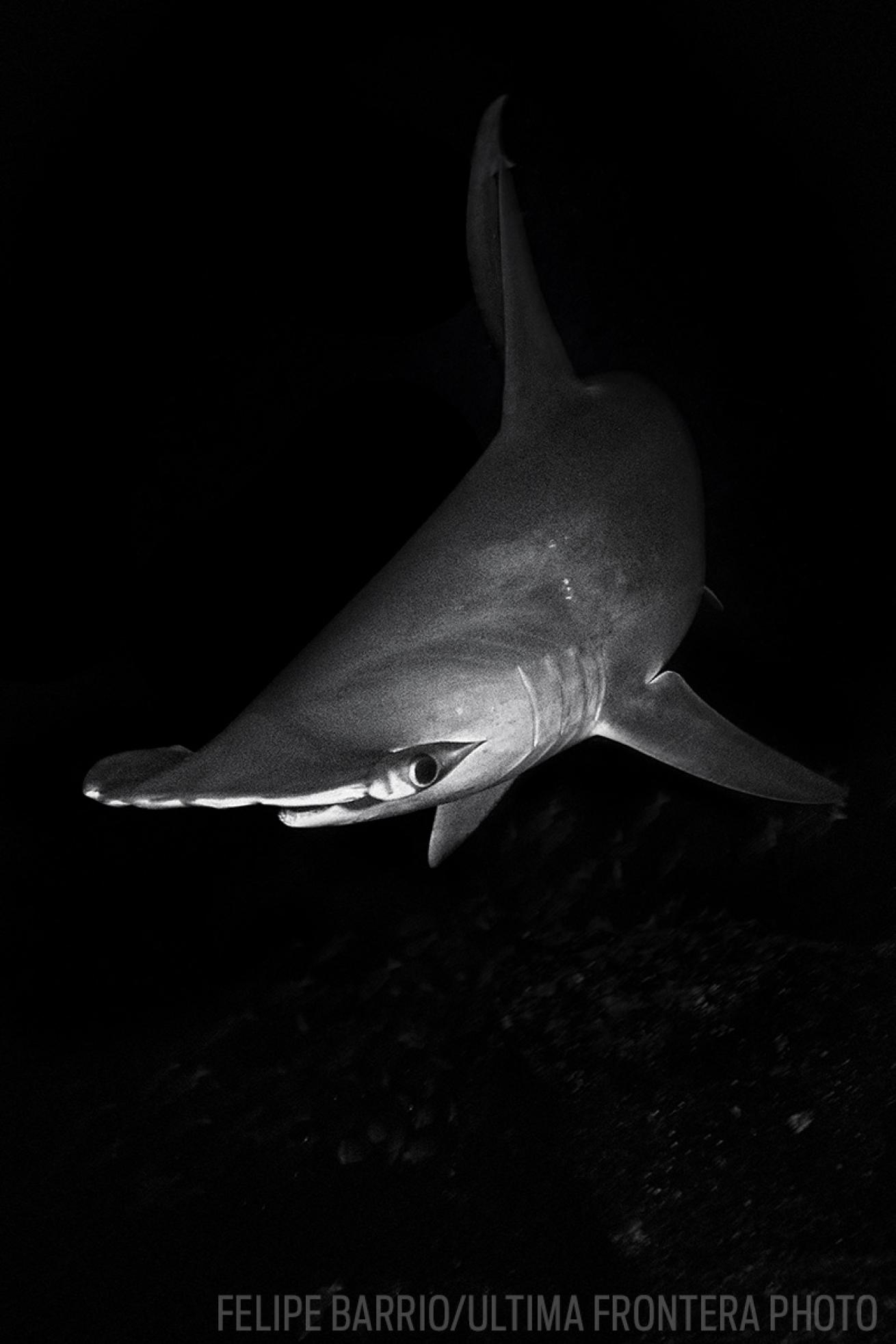
Felipe Barrio/Ultima Frontera PhotoWhile the hammerhead shark population has reduced in Cocos, the apex predators are still around — and an exciting encounter for scuba divers.
Where Have All the Hammerheads Gone?
Second rule of Survivorman: Do your homework. Know what you’re getting into.
Stroud scouts his locations carefully — including, potentially, Isla del Coco — to make sure he can deliver the episode he wants to create, and also to be sure he’s not somewhere he shouldn’t be (killing things in national parks, for example). Divers coming to Cocos should take a page: Show up in March, when the dreaded crossing from Puntarenas is easy, and you might be disappointed to find there are no aggregations in progress.
Seasonality is not the only factor. Fall is the time for masses of hammers so large that they almost blot out the sun, but recent years have failed to produce those numbers. Factors from El Niño to climate change to longline fishing outside the park’s “protected” area appear to be taking a toll. (What does this mean for divers? If you want to see Cocos, don’t delay.)
Despite its virgin appearance, Cocos has long been influenced by humans, including the damaging introduction of pigs, deer and as many as 100 other nonnative species. Cocos became a Costa Rican national park in 1978, and a UNESCO World Heritage site nearly 20 years later; rangers have been present in small numbers since the early 1990s. But all the protection Costa Rica can offer — which does not amount to much by U.S. standards: a handful of rangers and two small boats to monitor more than 700 square miles of open ocean — can’t overcome the commercial trawlers that lie in wait all the way up the eastern Pacific coast, an important wildlife corridor that stretches to Mexico’s Sea of Cortez. Sometimes even that slim protection has been selective — Sea Shepherd’s Paul Watson has been engaged in a 14-year legal battle with the Costa Rican government over his 2002 interception of a Costa Rican-flagged longliner shark finning in Guatemalan waters.
But a lack of aggregations doesn’t mean there’s not still mind-blowing abundance. Finning into the blue at the end of a Dirty Rock dive, we’re stunned to discover a much bigger school of jacks than the one usually present on the backside of the rock. Thousands and thousands of fish make up a school about 60 feet deep and easily as wide, each silver side catching and reflecting the sun’s rays. Then again, sometimes all it takes is a single animal.
“I know the tiger shark is there,” says mischievous Capt. Marcos Mauricio Marin as we prepare to return to Manuelita Deep, a favorite site.
Less than 10 minutes into our dive, we’re investigated by a 13-foot tiger with a dorsal so chewed, it looks fringed. It makes a wide pass on the sand 30 or 40 feet below, then comes back, a bit closer. And again, closer still. And again. For 20 minutes it stays in our vicinity, finishing with a thrillingly close pass — 10 feet, perhaps — over a diver who can’t stop giggling about it for the rest of the trip. We’re so delirious with joy that we barely notice two 300-pound yellowfin tuna bombing past — wild kingdom indeed.
Our last day breaks, and most are still abed. Not Bushman Bob, who’s become legendary on Okeanos Aggressor II for his solo 5 a.m. swims each morning. We admire for the hundredth time the waterfalls coursing down around us in Wafer Bay, and, at last, Bushman Bob gets the final word.
“Look at that beauty cascading down,” he says. “It’s a superstar, this island.” He smiles, and we turn to savor the fluffy dawn of one more day in paradise.
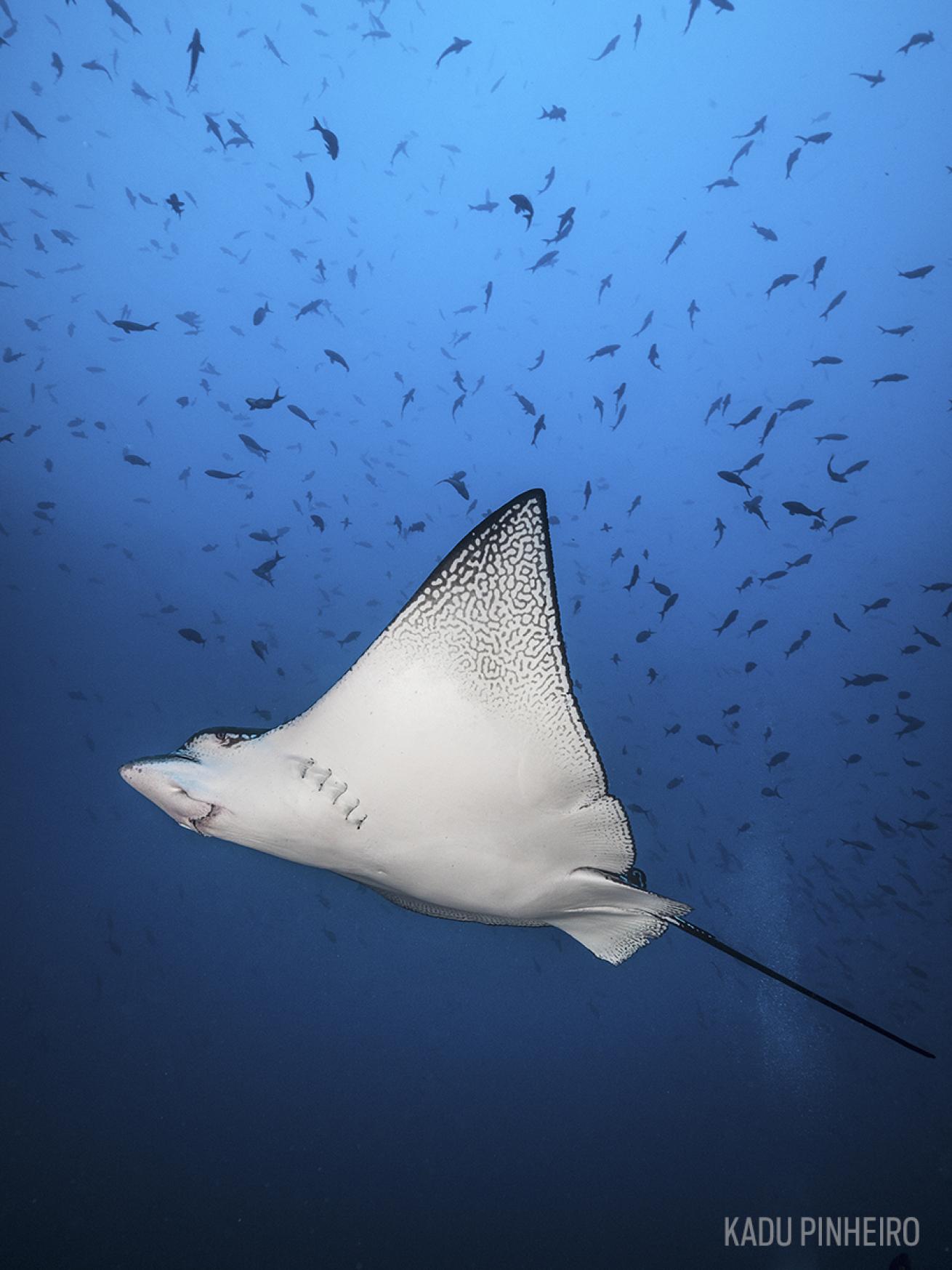
Kadu PinheiroAn eagle ray, present on practically every dive in Cocos Island, Costa Rica.
Scuba Diving Conditions in Cocos Island, Costa Rica
Currents can be stiff in Cocos; more dangerous is the changeability of open-ocean conditions. Diving in Cocos is not all advanced — but suddenly and without warning, any dive can become the most advanced of your career. If you’re a diver who really likes to motor around the whole dive, Cocos might not be for you — diving here can be more like hunting: Hunker down and wait to see what comes by. Usually the wait is not long for something amazing. Cocos is not a whim destination; expect experienced, engaged divers who’ve made a commitment — and likely broken into a few piggy banks — to make this pilgrimage.
When to Go
Cocos is a year-round destination, but what you might see varies by season. The famous hammerhead aggregations occur in fall, when the 36-hour crossing from mainland Costa Rica is often much rougher than in spring, when seas can be virtually flat. Many big animals — whale sharks, tiger and other types of sharks, eagle rays, devil rays, mantas, and hammers in smaller numbers — can be sighted at any time.
Dive Conditions
Water temps vary from 72 to 82 degrees F, with cooler — and warmer — thermoclines common. A 3 to 5 mm wetsuit is recommended. Strong currents can be frequent, especially at certain sites; pay attention to dive briefings.
Scuba Dive Operator
Aggressor Fleet operates two yachts in Cocos: Okeanos Aggressor I and Okeanos Aggressor II. Okeanos Aggressor I is 110 feet long with a 24-foot beam; it carries eight crew and up to 22 passengers in 11 staterooms with individual baths and climate controls. Okeanos Aggressor II is 120 feet long with a 27-foot beam; it carries nine crew and up to 22 passengers in 11 staterooms — three of them luxury — all with en-suite bathrooms. Both yachts spend part of the year at Cocos and parts at Caño and Bat islands and off Guanacaste, Costa Rica.
Cost for Scuba Diving
An eight-night cruise on Okeanos Aggressor II starts at $4,499; Okeanos Aggressor II 10-night cruises start at $5,299.
Help Protect Cocos Island, Costa Rica: Think Global, Act Local
Here are four things you can do to help ensure Cocos is still a superstar when your grandkids learn to dive.
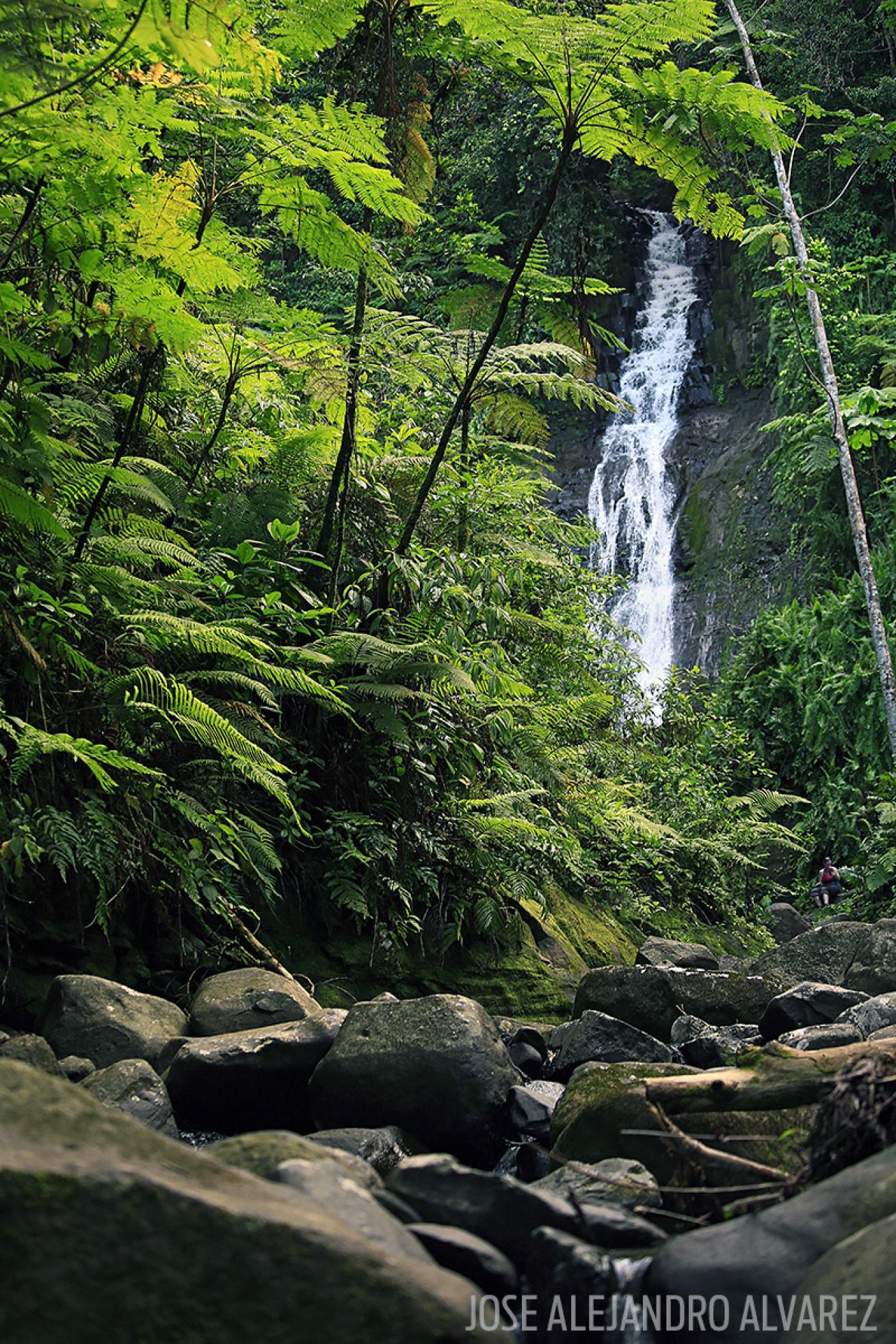
Jose Alejandro AlvarezTopside in Cocos Island, beautiful waterfalls create a landscape that looks like Jurassic Park.
Choose Your Seafood Wisely
Commercial fishing in the eastern Pacific endangers wildlife corridors critical to Cocos. Learn how your seafood choices impact the planet with Monterey Bay Aquarium’s Seafood Watch - seafoodwatch.org.
Say No To Plastic
We were surprised to find ourselves plucking plastic — 99 percent of it water bottles — from a Cocos bay. Still-visible labeling showed it had made its way there from literally all over the world.
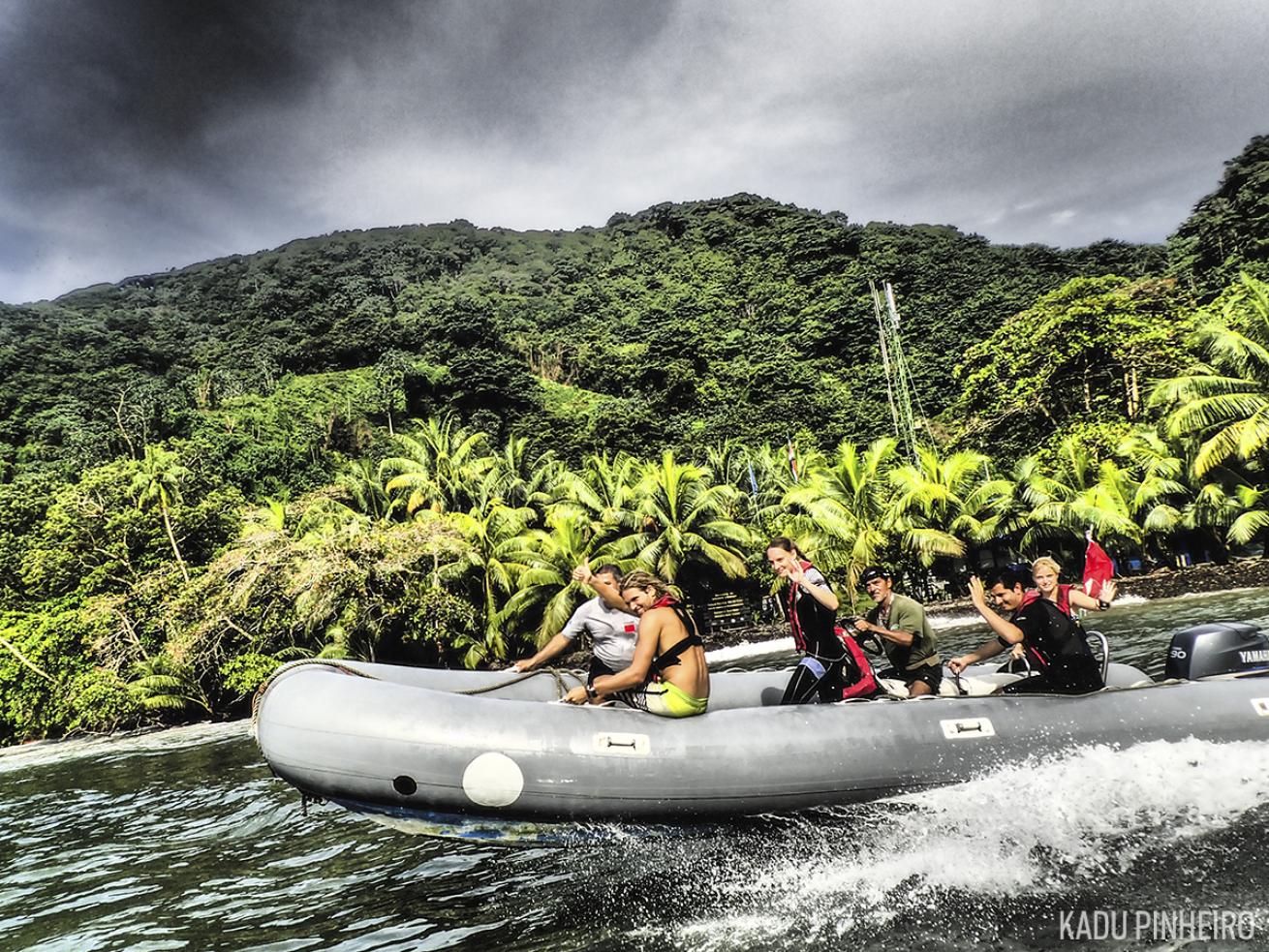
Kadu PinheiroHeading out for a scuba diving excursion in Cocos Island, Costa Rica.
Donate Directly to Cocos Island
Costa Rican groups like Pretoma are working to close the gap between conservation laws and the reality of underfunded protection mandates. Learn more at pretoma.org.
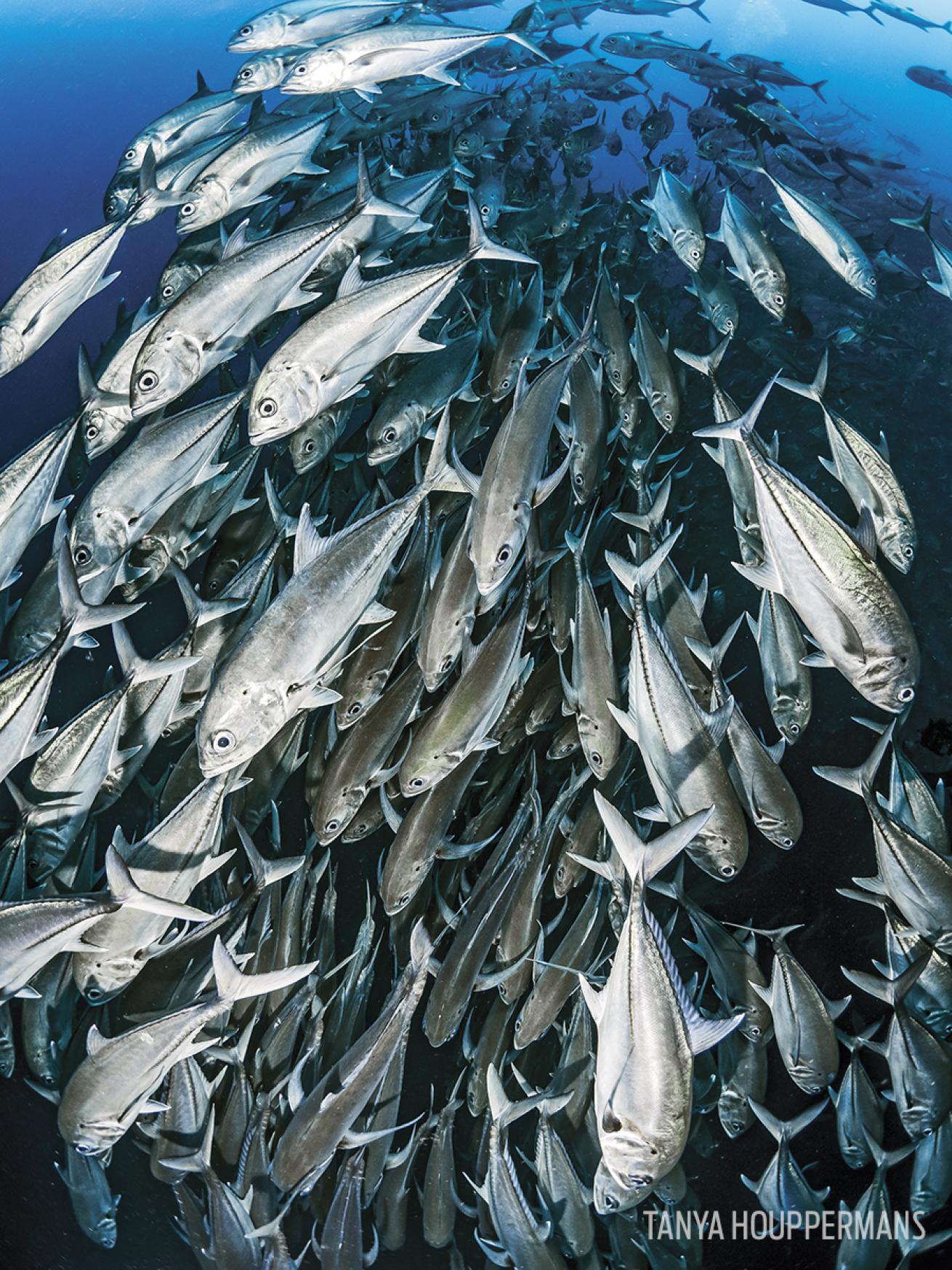
Tanya HouppermansSchooling jacks by the thousands put on a spectacular show for scuba divers when exploring Cocos Island.
Educate Children on Conservation
Kids exposed early to the undersea world develop lifelong awareness. Oceans for Youth is a 5,000-strong organization of volunteers that makes ocean-oriented presentations in local schools and youth groups. Join its ranks at oceansforyouth.org.
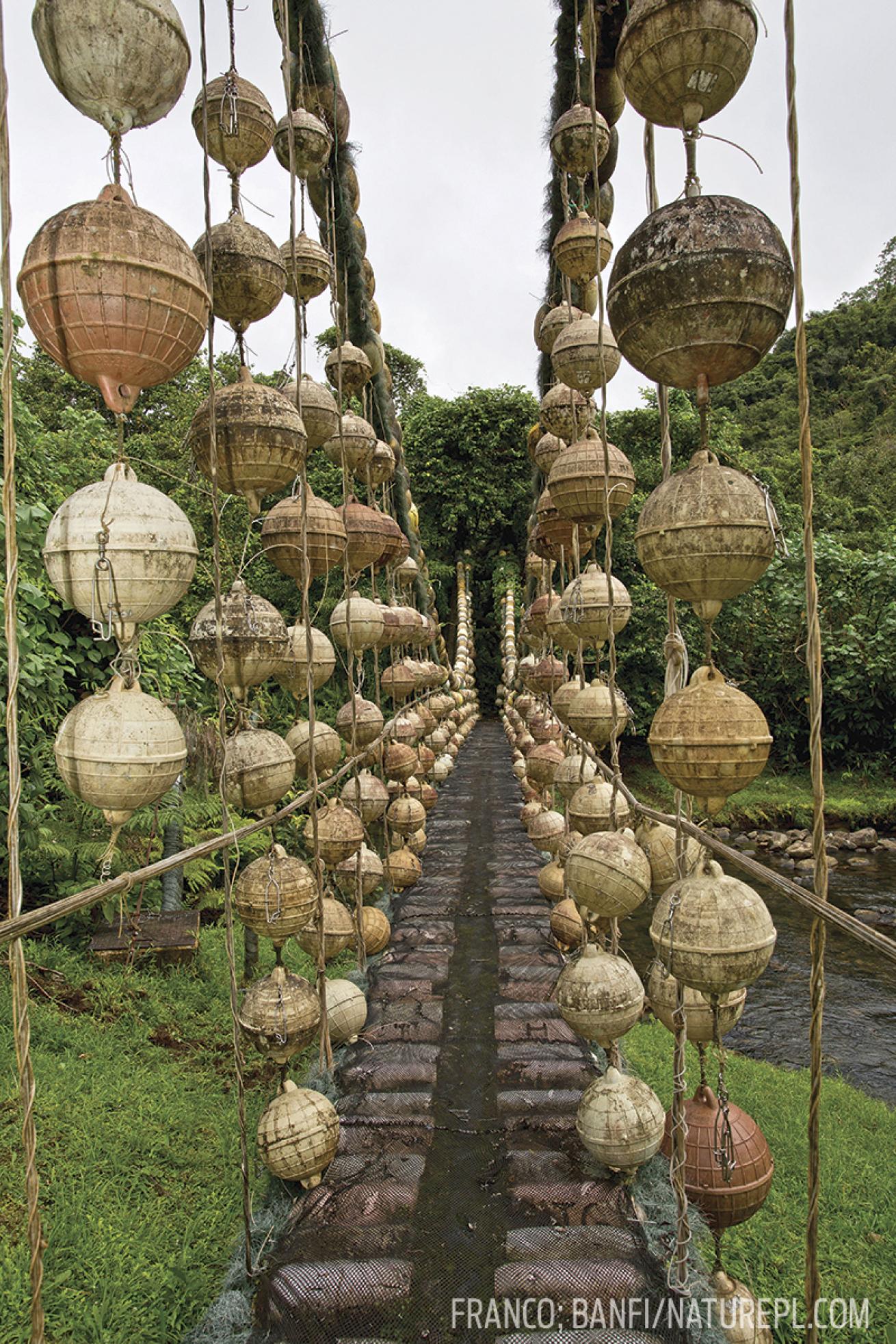
Franco Banfi/Nature Picture LibraryThis bridge in Cocos Island, Costa Rica, was made entirely of ocean refuse.

